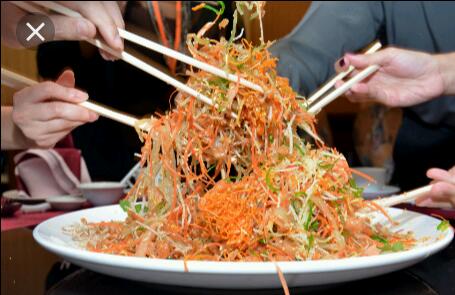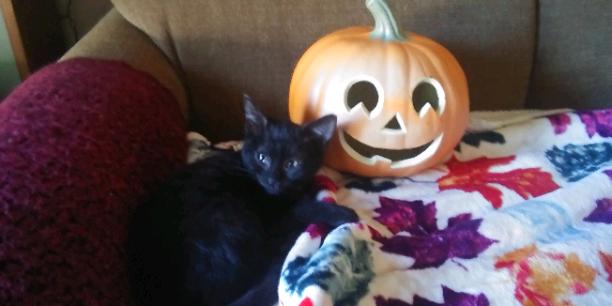
Category : Blogs
Sub Category : Miscellaneous
As promised, today I'm going to talk about a unique dish served during reunion dinner and all throughout Chinese New Year, a dish known as yee sang.
Yee sang, or also known as Prosperity Toss, is a Cantonese-style raw fish salad. It usually consists of strips of raw fish (most popular choice - salmon), mixed with shredded vegetables and a variety of sauces and condiments, among other ingredients. There is also a vegetarian version of this dish where the fish is replaced with soy 'fish', which resembles salmon. Yee sang literally means 'raw fish' but since "fish" (in Chinese) is commonly conflated with its homophone "abundance" (in Chinese), yee sang is interpreted (in meaning) as 'an increase in abundance'. Hence, yee sang is considered a symbol of abundance, prosperity and vigor.
While versions of it are thought to have existed in China, the contemporary version was created and popularized in the 1960s amongst the ethnic Chinese community and its consumption has been associated with Chinese New Year festivities in Malaysia, Indonesia and Singapore.
Today, the common form of yee sang is the 'qicai yee sang', which translates to 'seven coloured raw fish salad', served in local restaurants during the Chinese New Year period. This colourful take on yee sang is said to be created in the 1960s by four chefs who are known collectively as the "Four Heavenly Culinary Kings" in the Singapore restaurant scene. The recipe included ingredients such as shredded white and green radish, shredded carrots, ginger slices, onion slices, crushed peanuts, pomelo, pepper, essence of chicken oil, salt, vinegar, sugar and more. To enhance the taste, the chefs began the practice of pre-mixing the sauce in order to ensure a balanced taste for each dish as compared to the past where diners mixed the sauce themselves. This new way of eating yee sang was not readily accepted until the 1970s when younger diners embraced it. From then on, the popularity of this yee sang recipe soared and spread overseas.
There was a controversy between Singapore and Malaysia regarding the origins of this dish. It was said that a restaurant in Seremban, Malaysia first refined this dish from a Cantonese dish and sold it during Lunar New Year around 1940s. The son of the said chef acknowledged that it is hard to dispute the "ownership" of the dish. This dish has been declared a Malaysian heritage food by the Malaysian Department of National Heritage. One thing is certain though, this dish has its roots deep in the Southern part of China.
When putting the yee sang on the table, New Year greetings are offered. Some of the phrases commonly used are: "Gong Xi Fa Chai", which translates to "Congratulations for your wealth", and "Wan Shi Ru Yi", which translates to "May all your wishes be fulfilled".
When it comes to putting the dish together, there are specific steps and order that need to be followed.
First, the strips of fish are put on a platter. The fish in this dish symbolizes abundance. Pomelo or lime that is added to the fish symbolizes adding luck and auspicious value. Pepper is then dashed over in the hope of attracting more money and valuables. Then oil is poured, circling the ingredients, a symbol of encouraging money to flow in from all directions. Carrots are then added, indicating blessings of good luck. Shredded green radish is then added, symbolizing eternal youth. After which the shredded white radish is added, symbolizing prosperity in business and promotion at work.
After putting all the ingredients on the platter, the condiments are finally added. First, peanut crumbs are dusted on the fish, symbolizing a household filled with gold and silver. Sesame seeds quickly follow, symbolizing a flourishing business. Then yee sang sauce, usually made from plum sauce, is generously drizzled over everything - a reference to 'tian tian mi mi', which translates to 'may life always be sweet'. Deep-fried flour crisps in the shape of golden pillows is then added with wishes that literally translates to 'the whole floor would be filled with gold'.
Yes sang is often served as part of a multi-dish dinner, usually as the appetizer due to its symbolism of 'good luck' for the new year. Once the entire dish has been put together on a large platter, all diners present at the table then stand up and proceed to toss the shredded ingredients into the air using their chopsticks, while saying various auspicious wishes out loud, or simply saying out loud "lo hei, lo hei", which translates to " scoop it up, scoop it up". I swear I am NOT making this up. It is believed that the height of the toss reflects the height of the diners' growth in fortunes, thus diners are expected to toss enthusiastically.
Needless to say, it is quite a messy affair with pieces of ingredients flying all over the place. And yes, it is also a very noisy affair with lots of laughter filling the air.




